Encaustic tiles are eye-catching, patterned tiles that come in two to six colors and different types too . Unlike glazed patterns, that rest on the tile’s surface, the colors run into the tile itself and will not fade off over time. While encaustic tiles have been around for millennia, their strong, graphic patterns and rich colors make them a popular option for both traditional and modern homes.
They can be used alone or in combination with other methods of tiles, including such tessellated tiles, to produce a more detailed, decorative design. Encaustic tiles are indeed a prominent part of Colonial buildings, but they have a much longer history.
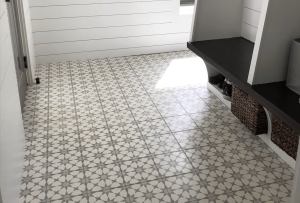
Between the 12th and 16th centuries, inlaid (or encaustic) tiles became popular in monasteries and palaces. However, with the destruction of monasteries, the expertise was largely lost till the Gothic Revival in the early nineteenth century. A growing interest in Gothic architecture and design created a new market for medieval inlaid tiles during this time period.
Herbert Minton, with the assistance of Samuel Wright, published a pattern book with 62 encaustic patterns regarding previous medieval forms in 1835. was commissioned in 1844 to design an encaustic floor for Queen Victoria’s Osborne House. This resulted in an increase in the popularity of encaustic tiles among architects.
The majority of encaustic tiles are made of fully vitrified porcelain, glazed porcelain, or cement. While one encaustic tile may appear similar to another at first glance, the material used and how the design is created make a significant difference in the tile’s function and durability.
One of the most popular forms of “encaustic” on the market today is “Moroccan” cement encaustic, which has the pattern imprinted onto the surface of a tile after it has been fired. These printed cement tiles were reasonably cheap, however they are exceedingly porous, discolor and chip quickly.
Victorian encaustic tiles
Victorian tiles are an encaustic tile that is well-known for its distinctive geometric designs. Victorian tiles are frequently used for restorations or historical replicas, but so many interested buyers are now using them for new buildings or modern design homes.
They are both stunning and bold, as well as detailed and busy, and make excellent accents to provide interest and pattern to both contemporary and traditional homes. Monks employed encaustic tiles for their religious buildings in the 12th century.
In the 16th century, Henry VIII abolished many monasteries, severely limiting the encaustic tile production for approximately 400 years. Encaustic tiles witnessed a renaissance at the beginning of the nineteenth century, and ceramic tile producers arose, making this material a common trend for not only religious facilities, but also private dwellings and commercial buildings.
The Victorian period and Edwardian Era span the early nineteenth century to the turn of the twentieth century, which is why this kind and style of tile is known as Victorian tiles. They are mostly British floor tiles that have been utilized in several hallways, conservatories, kitchens, bathrooms, and patios.
Many early Victorian tiles were black and white in hue, mostly in a checkerboard pattern. Victorian floor tiles are well renowned for their geometric shapes, which often include square, rectangle, diamond, or octagon designs. Another popular Victorian tile was mosaic floor tile, which came in a variety of rich hues and elaborate patterns such as Fleur-de-lis scrolls, flowers, birds, even literary characters.
Many Victorian tiles were created in a Harlequin style, employing royal colors such as blue, burgundy, and white, in addition to the basic black and white pattern.
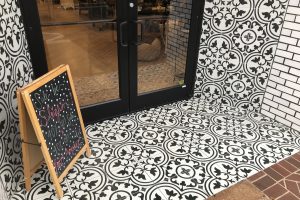
Encaustic tile backsplash
kitchen tile backsplashes have been practical for many decades. Normally by passing time Encaustic backsplash, more items and styles have emerged over time, providing homeowners with the opportunity to modernize their space, renew their design style, and push up the price of their kitchen.
Encaustic cement backsplash has recently become very popular, yet it is not a new product. Encaustic tile is the original tile, providing homes with the benefits and qualities of a long-lasting, time-tested material. Encaustic cement tile is also extremely versatile in terms of design and style, making it an excellent choice for a kitchen backsplash.
Learn something about what makes encaustic tile an excellent choice for your kitchen backsplash in this blog post. Part one of this piece discusses that encaustic cement tile backsplashes may enhance the look and feel of your kitchen. Part 1 highlighted that cement encaustic tile is one of the simplest, most cost-effective, and enjoyable methods to update your kitchen decor.
In this essay, we will discuss the numerous benefits and characteristics of this tile. Durability,If your kitchen is anything to go by ours, it is riddled with messes from preparing and cooking. To preserve your walls from daily wear and tear, you’ll need a protective barrier.
Encaustic tile backsplashes may withstand regular abuse and yet look great after a kitchen disaster. In fact palaces such s kitchen backsplash that deals with high damp, water or moisture must be extremely prous in order of resistance infront of them and porous encaustic tile backsplash won’t decay for these reasons easily.
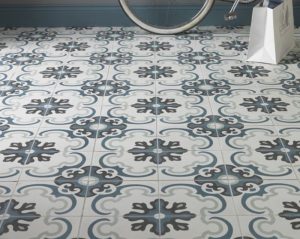
How to make encaustic tiles
Encaustic cement tiles, sometimes known as cement tiles, are entirely handcrafted. They are composed of concrete, as well as the color in the design is created by mixing mineral pigments and pouring them into a mold. This approach was created in the mid-nineteenth century and has not altered significantly since then.
Unlike other decorative ceramic tiles, this pattern also isn’t painted and glazed. A mold is used to inlay the pattern into the body of the tile. Encaustic cement tiles are called a “green product” because they are not burnt in a kiln and may be made with locally available materials.
The tiles are ideal for the both outdoor and indoor settings that do not experience harsh freezes. The tiles are long-lasting and, best of all, entirely customized. To ensure color uniformity, the color layer is manufactured in batches and each component is weighed.
To combine the combination, the color is mixed inside a horizontal mixer. Water is mixed into the color mixture before it is hand poured into the various areas of the mold that makes the design. If there is no pattern, the same color is utilized for such entire color layer, and also no pattern mold is needed.
The color layer would always be between 3 and 5 millimeters thick, following materials have been used in the color layer: Portland white cement, Marble sand Calcium carbonate Silica sand Iron, cobalt, and chromium oxides are mineral pigments.
On top of the color layer, two layers comprising cementitious material are poured. The tile’s middle layer is made of a Portland cement and fine sand mixture that produces a strong binding between the patterned surface and the tile’s base. The encaustic tile’s third, or foundation, layer is made from a mixture of fine and ordinary cement, sand, and limestone powder.
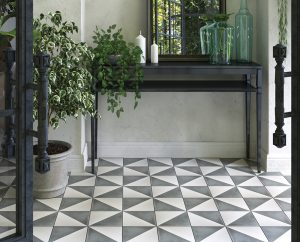
Encaustic floor tile
Encaustic tiles are ceramic tiles wherein the pattern or design on the floor is created using different colors of clay rather than glaze. They are normally in variety of colors, although a tile might be as more than six for floor applications. Encaustic floor tiles can be glazed or unglazed, and the inlay can be as shallow as 18 inch (3 mm), as is typically the case with later medieval “printed” encaustic tile, or as thick as a quarter inch that is proper for floor covering.
Victorian tiles are best known for their finely tiled floors, which can be seen across Europe, Asia and the United States, but they have also been employed to construct artistic wall features, fireplace mantels, patios, and outdoor paths. Victorian tiles transformed otherwise ordinary floors and walls into intriguing works of art, and they have always been quite durable.
Since its introduction in the early nineteenth century, Victorian tiles have been employed to create ornate floor medallions, patios, walkway, and tiled rugs or runners. They can be used to divide spaces and create the illusion of many types of flooring.
Aristocratic homes frequently used customized tiles with a family crest or insignia that were incorporated into the floor or wall decor. encaustic floor tiles will look great in a vintage home floor. Encaustic floor tiles, indoor and outdoor tiles in classic black, red, and white combinations, as well as more odd colors used as accents including such blue, green, pink, and lime.
Many of users want to use these traditional encaustic tiles in a contemporary approach. It also provide bespoke tile sizes and shapes, which is ideal for any restoration projects that require matching and replacing missing or broken tiles on an area with original Victorian patterned floor tiles.
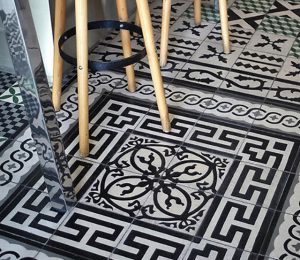
Encaustic tile bathroom
There are numerous bathroom encaustic tile ideas. These ceramic or cement wall and floor coverings, formerly the purview of every self-respecting Victorian hallway, have come a long way and now discover themselves in the coolest of bathrooms.
While the Moorish Mediterranean design is popular, it’s not simply the typical Moroccan, Spanish, and Portuguese patterns (often found in cathedrals and mosques) that are popular for bathroom tile ideas. These colorful, repetitious clay (or cement) tiles are now obtainable in graphic and modern motifs such as stripes, geometrics, and swirls.
Encaustic tiles were traditionally formed of two or more colors of clay that were inlaid together to create a beautiful pattern, with the color coming from the clay rather than a glaze. Many of the tiles on the market now are encaustic-style cement tiles, with the repetition pattern and color created by a pigment inlaid in a cement tile (that is compressed in its manufacture rather than fired in a kiln).
In either case, the pattern is applied via the tile rather than as a glaze on the surface. Both are lovely, however if you would like to know how to care for them properly, consult with the maker. Check out the suggestions below, and whichever you decide, encaustic tiles will make a big difference.
When employing striking designs, it’s tempting to tile only a portion of the space, perhaps only a section prone to spills. However, as it is ibvious, tiling a bold design, such as temporary from proper encaustic floor tiles, from floor to ceiling, combined with simple bathroom flooring gives a fashionable spot to lie back and relax.
Encaustic tiles outdoor
Encaustic tiles may resist outdoor conditions in well-protected areas, such as a covered patio or a terrace inside a Mediterranean environment. Nonetheless, because these tiles are somewhat porous, they may develop minor cracks or chips if exposed to ice or become clogged with moisture.
To assist alleviate these frost-related difficulties, we recommend the following: Install the tiles on a concrete screed that is impermeable or totally waterproofed. Lay the tiles with a second layer of adhesive; otherwise, pockets of water underneath the tiles could cause them to loosen or crack in the event of frost.
Use an outdoor-appropriate adhesive. To avoid water infiltration, the connections must be well-made and well-maintained. A sufficient inclination is essential to quickly drain water and prevent puddles. Aside from adequate drainage, we advise that you re-seal the tiles on a regular basis (every 12-18 months). If laid outdoors, some of the colors may fade due to sunshine or acid rain.
The extent of inconvenience caused by this, however, is determined on your personal tolerance and taste. Some people enjoy the’mellowed’ or ‘aged’ effect that this produces. Tiles in our outdoor collection can be used on outdoor floors such as terraces, patios, and walks, as well as walls, bars, and other structures.
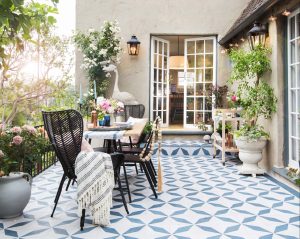
Encaustic cement tile that offers a contemporary-yet-classic aesthetic to outdoor settings, is one of the most great recreational floor tiles. This tile, including some of our other patterned designs tiles, are ideal for creating a great focus point in any garden, and will brighten it up even on the darkest of days. Encaustic outdoor glazed tiles are yet another excellent choice for use outdoors (as long as they are not used on floors) because they are easy to keep, weatherproof, and gleam in the sun.

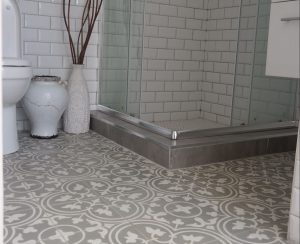
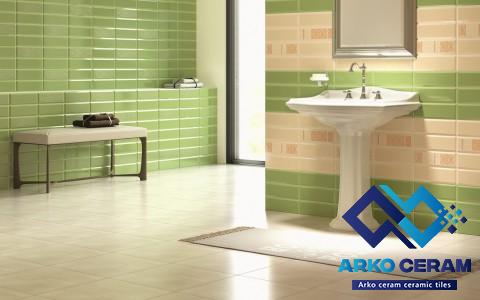
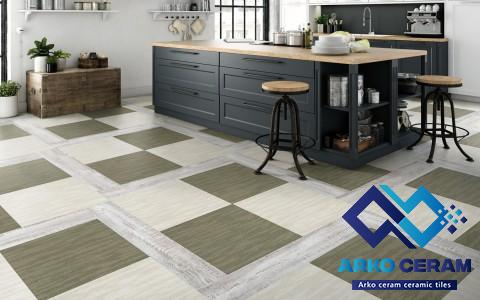
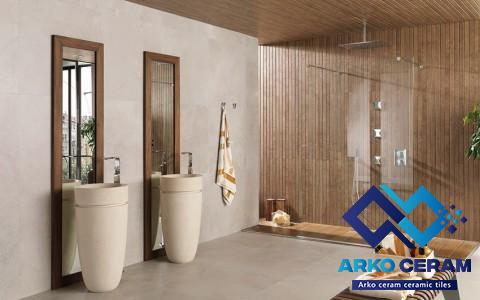



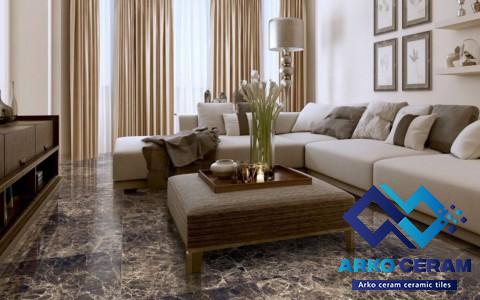
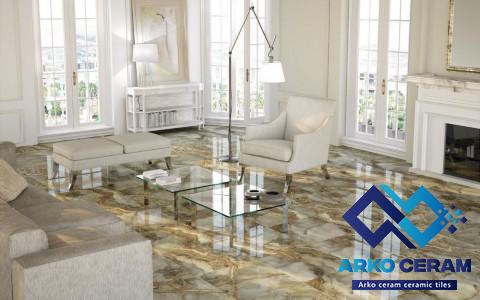
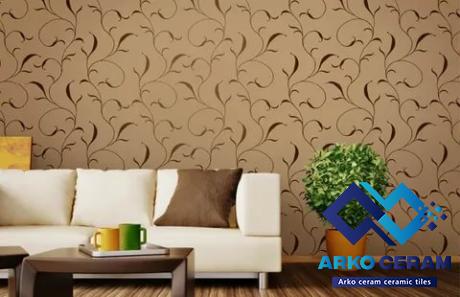
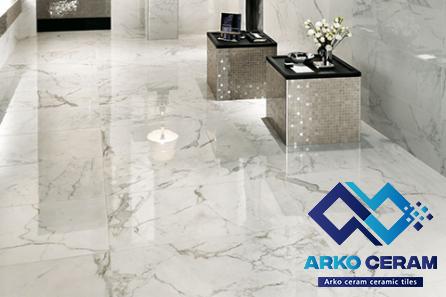
Your comment submitted.